This was published 6 years ago
Appenzell whisky trek, Switzerland: The most unlikely destination for a whisky trek
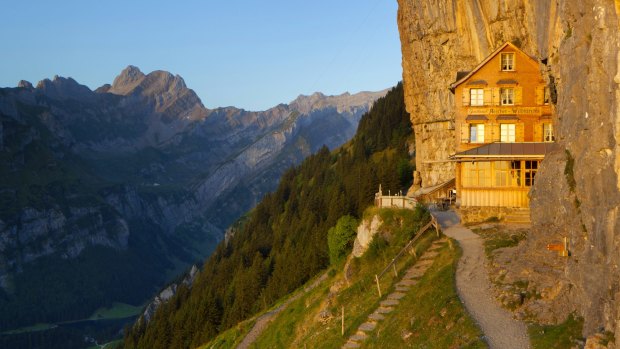
Whisky trekkers can stop off at Aescher-Wildkirchli, which is built directly into Ebenalp rock face. Credit: Roland Gerth
An innkeeper abandons his lunchtime kitchen post so I can experience the aromas and heady views of the nosing hut. Further down the track, another keeper opens the door of her purpose-built lakeside space to reveal the family barrel. Up at 1600 metres, a mountain man wearing a Batman T-shirt leads me into an ancient stone building to show off the cask. I'm on the world's highest whisky trek in a place called Appenzellerland.
In Switzerland's north-east, near Austria and Liechtenstein, two cantons entwine like twins in utero within the belly of another called St Gallen. Appenzell Innerrhoden, the country's second smallest and least populated canton, is more than 500 years old with a documented yodelling heritage almost as long. Conservative even by Swiss standards, women only gained the right to vote on local issues in 1991.
Two hours from Zurich, between gentle green pastures and subsiding farmhouses I'm to discover I can't always stand up in, the train slows on approach into the canton's capital. From Appenzell station, it's a short walk to the village centre and across the river to Appenzell brewery – in the Locher family since 1886. But I'm not here for beer.
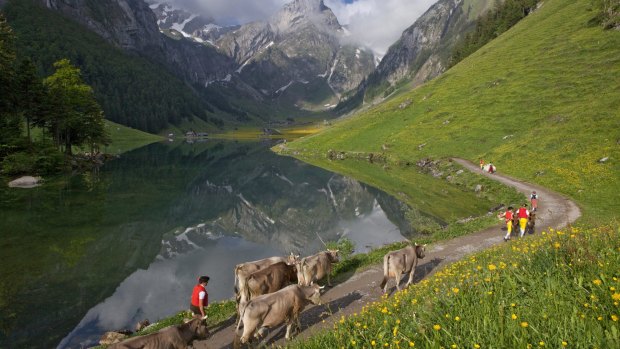
Alpine herdsmen dressed in traditional Appenzell costume walk next to Seealpsee lake in Switzerland.Credit: Christof Sonderegger
I purchase a pad of nine Appenzeller whiskytrek tickets and that comes with a vintage-style booklet in German. Photographs inside show a wooden barrel carried on shoulders in the breath-condensing cold of morning, another transported up a gravel road on a horse-drawn cart, moody cloud-shrouded mountains, a stony peak touched by sun, isolated farm buildings dwarfed by a rock-face backdrop.
There were some funny looks when I said I was going to Switzerland for whisky, but the Appenzell has spring water flowing from the Alpstein, peat in nearby highlands and robust barley growing at elevated altitudes. Its late arrival to whisky distilling was only due to one factor: the law.
In 1999, when Switzerland's ban on grain-based spirit production lifted, brewer Karl Locher added whisky to his repertoire and, by 2002, put the country's first single malt on the market. Internationally award-winning Säntis Malt is aged in the brewery's oak beer barrels – most over a century old and all cleansed inside by fire.
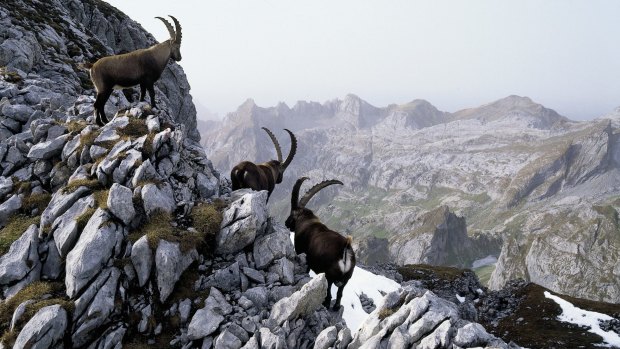
Ibex are native to the Alpstein.Credit: Christof Sonderegger
A couple of years ago, Säntis Malt whisky was distributed to all 27 guesthouses of the Alpstein to age at various altitudes in cellars, caves, huts, attics and trees within casks previously used for sherry, port, wine, bourbon. Like Locher Brewery, most Alpstein inns are multi-generational family-owned businesses.
I rip off the top ticket and hand it back over the counter to local woman Kathrin Baumann who exchanges it for a 10-centilitre bottle of Säntis Malt. "For the others," she says, "you have to go to the mountains".
The Alpstein massif is a prime example of Switzerland's compact nature; from Appenzell it's only 30 minutes on trains to Hoher Kasten cable car. At the summit, I recognise the view out towards Säntis – the highest mountain of the Alpstein at 2502 metres – from the whisky trek booklet's monochrome cover.
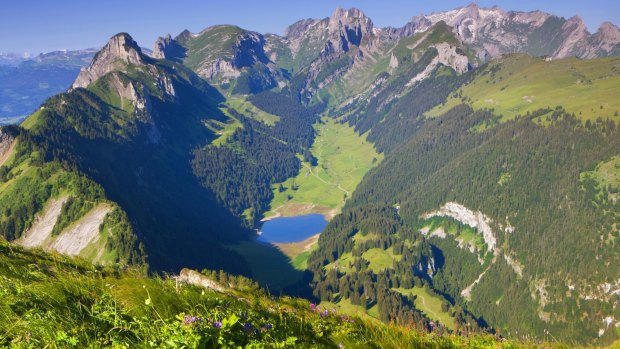
View from Hoher Kasten mountain towards Säntis, the highest mountain in the Alpstein massif of northeastern Switzerland. Credit: Roland Gerth
Other hikers tell me it's "up and down, up and down" from Hoher Kasten to Staubern. The clear signage gives times rather than distances and certain guesthouses have a wine glass symbol next to their name. "So many restaurants," someone says.
Three hours later, pork schnitzel and salad is placed in front of me by Gisela Lüchinger-Krüsi, who has lived her entire life in this house overshadowed by Staubern's craggy 1860-metre tip. After I've eaten, her middle-aged son organises me a sample directly from the barrel and explains – in Swiss German, of which I know little, but somehow we make it work – that they've had whisky for two years and the hut for 10. Only when Daniel returns to the kitchen and I start hiking again does it occur to me that lunch is not the time to monopolise innkeepers. Everyone at Staubern, though, was too polite to even insinuate it.
In this elevated world, ridgetop views down into the populated valley soon give way to scenes of the massif's interior – steep grassy meadows of wildflowers and livestock, weathered timber fences, stands of forest, long scree slopes, dramatic gullies, vertical limestone cliffs. Cowbells are often the only sound and it feels timeless until a helicopter bearing a bull in a sling flies over.
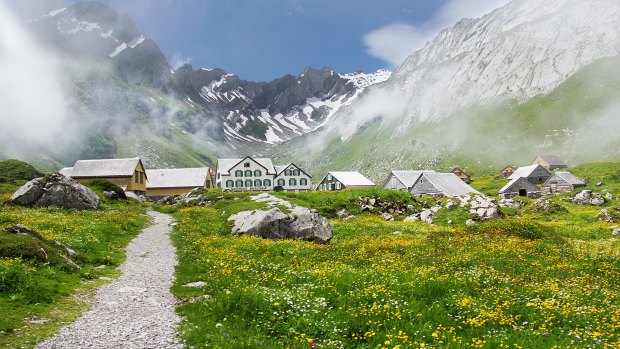
Meglisalp guesthouse.Credit: Viviane Schmid
Trails are classified as wanderweg, alpiner weg and bergwanderweg. Wanderweg is a graded footpath, while alpiner weg is minimally maintained and may require mountaineering ropes. Bergwanderweg, which I tread for three days, is somewhere in between.
I overnight at the pretty and popular Bollenwees, but one innkeeper there has less patience than a tired toddler for a monolingual moron like me and I leave pre-dawn the next day to shake it off. In the half-light and crisp air, I cross paths with a stocky farmer in shirt and trousers who's probably been up for hours walking this land his family has worked for generations. Ibex and marmot have shared these alps with cows and their patient cheese-making owners for centuries.
At Meglisalp, it's too early to drink whisky but I exchange one of my tickets – they speak a language of their own – for a bottle. I'm outside drinking coffee and eating my second self-serve chocolate-filled pastry when the sun hits the face of the main building.
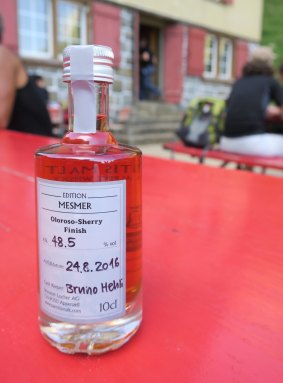
A whisky trek is not a trek unless there is some whisky..Credit: Elspeth Callender
On the cliff-edge descent to Seealpsee, the foliage growing up the wall – it creates the false sense of a wider path – and the calm confidence of other walkers keeps me from getting the shakes. I'm also grateful the whisky is in my pack and not my bloodstream.
Fifty-five bed Seealpsee is only 90 minutes on foot from Ebenalp cable car, so people often "come for breakfast, drink a coffee and go home", explains Madeleine Parpan-Dörig whose family has owned and run this guesthouse for three generations. Other patrons, she says, are whisky trekkers who tend to buy a nip with lunch and carry their 10cl bottle home unopened. She's discovered that all sorts of people are interested in tasting each inn's whisky.
Seealpsee's has been in a cognac barrel for three years and was driven up here on the back of a 1971 truck by Madeleine's 13-year-old son. Each Alpstein restaurant has also developed their own Säntis Malt eating experience, like a boozy dessert or a sausage made with whisky. Seealpsee offers "whicknics'', sending you out on the lake in a dinghy with an adults-only picnic hamper.
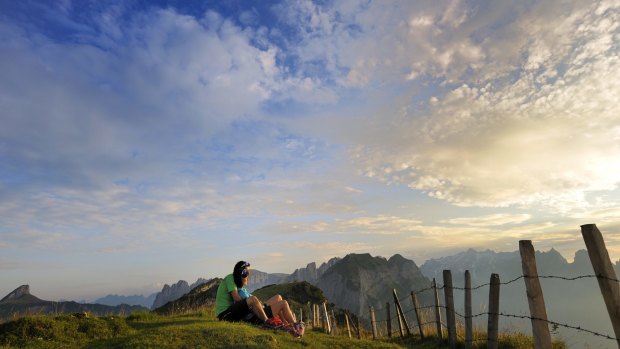
Hikers stop to enjoy the ridgetop views while trekking between Ebenalp and Schafler.Credit: Christian Perret
The next morning, as day-trippers converge on Seealpsee, I head the opposite direction up a series of switchbacks on a 500-metre altitudinal climb to the next inn. At Mesmer the mood is high; walkers are buzzing from the weather and their achievement. Although there's very little language overlap with innkeepers Monika and Bruno Hehli or their employee, Urban, we still share a string of jokes for the hour or so I'm there.
For a long stretch between Mesmer and Schäfler, there's a serious drop-off on one side of the trail but a cable to hold onto in places. I pass a family with their child on a leash.
It's lunchtime when I reach Äscher – perched and golden, pressed up against the cliff. Close to Ebenalp cable car and being a sunny Sunday, the place is packed. Thirtysomethings from St Gallen, who see me collect my Äscher bottle, tell me they bought the 27-ticket whisky trek pack the previous year; that one comes with a display cabinet and each ticket has an Alpstein inn name on it. Over two months of summer weekends like this, they collected every bottle. Favourites: Shäfler, Lehmen and "Seealpsee is a good one".
"It's incredible how many people come to buy whisky," Madeleine told me as she unlocked the "windy palace" where their cask is mounted. Within these split timber walls, Seealpsee hosts intimate cheese and whisky tasting experiences by prearrangement.
Because of the popularity of the whisky trek, high altitude supplies may drain by late-2017 so the time for getting into the spirit is now. But, regardless, the Alpstein and Säntis Malt aren't going anywhere anytime soon.
TREK
Buy your nine-ticket (CHF150) or 27-ticket (CHF400) set from Locher Brewery (appenzellerbier.ch) or Appenzell tourism office. See appenzell.info
The best time to walk is weekdays from May to September. Trekking options are many, but my route was Hoher Kasten, Staubern, Bollenwees (overnight), Meglisalp, Seealpsee (overnight), Mesmer, Schäfler, Äscher, Ebenalp.
FLY
Swiss International Air Lines, along with airline partners, offers daily connections from Sydney and Melbourne via Hong Kong, Bangkok and Singapore. See swiss.com
RAIL
A Swiss Travel Pass gives unlimited access to Switzerland's trains, trams, buses and boats and discounts on mountaintop trains and cable cars. See myswitzerland.com/rail
STAY
Hotel Café Adler in Appenzell's village centre has its own bakery and cafe and a 1562 wine and fondue cellar. Rooms for two from CHF185 a night, breakfast included. See adlerhotel.ch
TAKE
Cash for mountain accommodation and meals, coins for showers and a travel towel.
Elspeth Callender travelled as a guest of Switzerland Tourism and Appenzell Tourism.
FIVE MORE ACTIVE SUMMER EXCURSIONS IN SWITZERLAND
RHINE RAFTING
From the town of Chur, take a one-day white water rafting trip on the Ruinaulta – a canyon of the Anterior Rhine.
PINUT VIA FERRATA
This restored 1907 via ferrata has 27 ladders, hundreds of steps and views in all directions. If you're fresh to via ferrata, organise a guide for the half-day.
BASEL E-BIKE TOUR
This one-day, 70km electric bike experience takes in the city of Basel and beyond to Liestal and Sissach, the Fricktal Jura and Rheinfelden.
ANDERMATT HIKE
For a challenging multi-day hiking adventure, explore this area's alpine landscape on foot and stay overnight in mountain huts.
MOTORCYCLE TOUR
Hire a Harley-Davidson and take the Grand Tour of Switzerland with the wind in your face and Swiss summer smells up your nose.
Sign up for the Traveller Deals newsletter
Get exclusive travel deals delivered straight to your inbox. Sign up now.